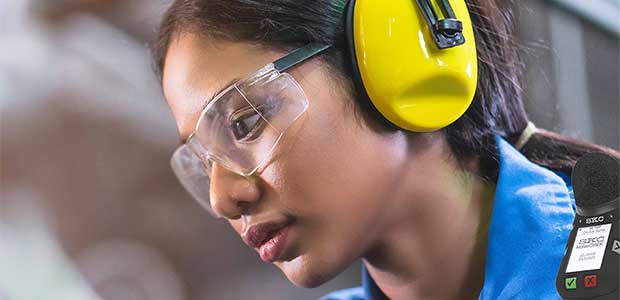Benefits of protecting employee health
Work noise-related hearing loss is almost entirely preventable. OSHA hearing testing is important. If unaddressed, hearing loss negatively impacts communication, cognition, education, employment, mental health, and interpersonal relationships. Over 22 million U.S. workers are exposed to hazardous workplace noise. Approximately 16% of adult hearing loss results from exposure to excessive noise in the workplace. The World Health Organization’s World Report on Hearing (2021: https://www.who.int/teams/noncommunicable-diseases/sensory-functions-disability-and-rehabilitation/highlighting-priorities-for-ear-and-hearing-care ) indicates that timely identification and management of ear and hearing problems over the next ten years will result in a return of about $16 dollars for every dollar invested. Workers who can hear alert and alarm systems, and speech, are safe and productive workers.
Hearing loss and tinnitus prevention
Hearing loss progresses over time. Often, a person doesn’t even notice that they have lost hearing until they are tested. Age can contribute to hearing loss but, for many people, hearing loss results from unprotected, continuous damaging noise exposure for prolonged periods of time. Additionally, more than 25 million U.S. adults experience tinnitus, or the perception of sound when no actual external noise is present, (https://www.ata.org/about-tinnitus/why-are-my-ears-ringing/#facts). Two million adults experience debilitating tinnitus. Unprotected exposure to hazardous noise is one of the leading causes of tinnitus.
Offering hearing protection devices for workplace use, such as earplugs or earmuffs, is not enough to prevent both hearing loss and tinnitus. For years, we have recognized that the best ways to prevent hearing loss and tinnitus are: physically remove the noise hazard from the work environment, substitute quieter equipment, implement engineering controls to isolate the worker from the noise source, implement administrative controls to reduce the worker’s noise exposure through process changes, such as exposure time limits.
Some simple ways to prevent recreational hearing loss are:
- Turn down the volume
- Move away from the loud noise
- Take breaks from loud noise
- Always use hearing protection and use it correctly
- If you or someone who speaks with you often suspects that you are having difficulty hearing speech in the presence of everyday background noise, have your hearing tested by an audiologist.
Also important is to remember that all blast-type noise requires hearing protection, such as from gunfire and air tools.
OSHA Hearing Conservation Program

OSHA requires that employers “shall administer a continuing, effective hearing conservation program, …whenever employee noise exposures equal or exceed an 8-hour time-weighted average sound level (TWA) of 85 decibels measured on the A scale”. The National Institute for Occupational Safety and Health (NIOSH) recommends that workers should not be exposed to noise at a level that amounts to more than 85 decibels (dBA) for 8 hours. OSHA’s occupational noise exposure regulation, 29 CFR 1910.95, includes: noise monitoring,OSHA audiometric testing, hearing protectors, training, and recordkeeping (https://www.osha.gov/laws-regs/regulations/standardnumber/1910/1910.95).
While noise exposure measurement and an OSHA hearing test identify which workers are exposed to hazardous work noise and who is appropriately protecting themselves at work and outside of work, only effective hearing loss prevention education, consistent and proper hearing protector use, and careful review of program records ensure a successful program and safe employees.
Conclusion
Hearing loss from workplace noise exposure is permanent, painless, and progressive, but it is also preventable. Effective hearing conservation programs include a team of participants: occupational hearing conservationists, occupational audiologists, occupational and public health nurses, physicians, and most importantly, employers and workers. While providing appropriate hearing protectors and checking their fit are critical to hearing loss prevention, hearing conservation education at the time of an OSHA hearing test and annually ensure workers know why, when, and how to protect their hearing over their lifetime.

